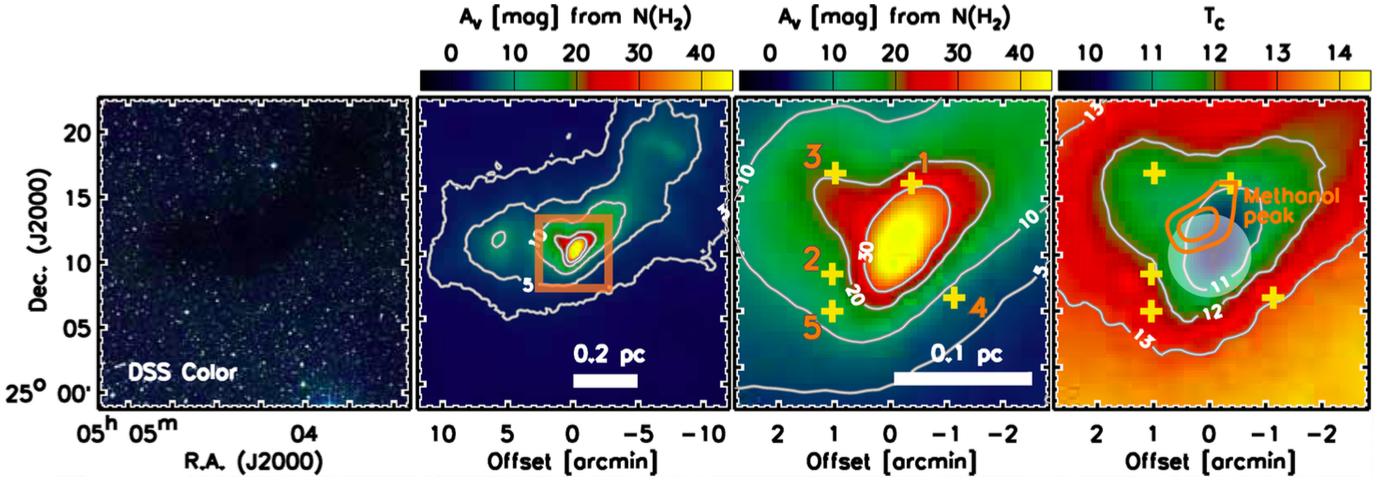< Summary (English) >
Astronomers have discovered that methanol and complex organic molecules are present in cold starless cores, where a standard warm-up scenario would not work due to the absence of heat sources.
A recent chemical model suggests that the presence of these molecules can be attributed to efficient chemical desorption and a class of neutral-neutral reactions that proceed fast at low temperatures in the gas phase.
The researchers used medium resolution spectroscopy toward three field stars behind the starless core L 1544 to constrain methanol ice abundance and compare it with model predictions.
They found that one of the stars had a methanol-ice abundance of 11% with respect to water ice, which is higher than previously found in cold cloud cores but still lower than predicted by the model.
Korean Summary:
천문학자들은 낮은 축전 상태에서는 열 소스가 없는 별 없는 광원에서 메타노올과 복잡한 기질 분리물질이 발견되었다.
최근의 화학 모델은 이러한 분리물질의 존재를 효율적인 화학 소결화와 저온에서 빠르게 진행되는 가산 중립-중성 반응으로 설명한다.
연구자들은 별 없는 광원 L 1544 뒤에 위치한 3개의 필드 스타에 대해 중간 분해력 스펙트로스코피를 사용하여 메타노올 아이스 부분 합성을 제약 설정하고 모델 예측과 비교했다.
한 필드 스타는 물 아이스에 대한 11%의 메타노올 아이스 부분 합성을 보였으며, 이는 낮은 축전 상태에서 발견된 기존 분리물질보다 더 높지만 여전히 모델의 예측과 일치하지 않는다.
Technical Terms Explanation:
* Methanol ice (메타노올 아이스): 축전에서 냉동된 메타노올
* Chemical desorption (화학 소결화): 분리물질의 광원으로부터 화학적으로 발생하는 과정
* Neutral-neutral reactions (중성 반응): 가산에서 발생하는 중성 분자들이 상호작용하여 발생하는 화학적 반응
Related Papers or Resources:
[1] Title: “Astronomy & Astrophysics manuscript no.
aa”
Author/Source: ESO (European Southern Observatory)
URL: https://www.
eso.
org/publications/astronomy-astrophysics-manuscript-no-aa
[2] Title: “Astrochemistry — (ISM:) dust, extinction — ISM: clouds — (ISM:) evolution — ISM: molecules — ISM: individual (L 1544)”
Author/Source: N/A
URL: https://ui.
adsabs.
org/search/q=astrochemistry%20(ISM:dust,extinction)%20(ISM:clouds)%20(ISM:evolution)%20(ISM:molecules)%20(L%201544)
[3] Title: “Interstellar chemistry”
Author/Source: N/A
URL: https://en.
wikipedia.
org/wiki/Interstellar_chemistry
< 요약 (Korean) >
< 기술적 용어 설명 >
< 참고 논문 또는 관련 자료 >
< Excerpt (English) >
< 번역 (Korean) >
AA © ESO 2020 2020 2020 년 12 월 22 일 L 1544의 물과 메탄올 빙.
Ludwig-Maximilians-Universität, Scheinerstr.
1, 81679 독일 München 2 Ural Federal University, 620002, 19 Mira Street, Yekaterinburg, Yekaterinburg, Russia 이메일 : Anton@urfu.ru 3 방문 연구원 방문, Ventspils International Radio Astronomy Center, Inženieru 101, LV-3601, Ventspils, Latvia 4 Max-institut fututut thututitut thututut chertitut fututitche Physik, Giessenbachstrasse 1, 85748, Garching, 독일 5 Centro de Astrobiología, Instituto nacional de técnica aeroespacial ctra de torrejón ajalvir, km 4 28850 Torrejón de Ardoz, madrid, Spain 6 Univers 6 Univers.
Carretera Tijuana-Ensenada 22870 Ensenada, BC, BC, 멕시코 7 Universität Wien, 천체 물리학과 Türkenschanzstraße 17 (Sternwarte), 1180 Wien, 오스트리아 12 월 22 일 초록 상황.
메탄올과 복잡한 유기 분자는 열원이 없기 때문에 표준 워밍업 시나리오가 작동하지 않는 콜드 스타 코어에서 발견되었습니다.
최근의 화학적 모델은 메탄올 및 큰 유기물의 존재가 효율적인 화학적 탈착과 기체상의 저온에서 빠르게 진행되는 중립 반응의 부류에 기인 한 것으로 기인했다.
목표.
이 모델은 콜드 클라우드 코어에서 공동 동결 아웃 영역의 가장자리에 높은 풍부한 메탄올 얼음을 요구합니다.
행동 양식.
우리는 메탄올 얼음 풍부도를 제한하고이를 모델 예측과 비교하기 위해 3 µm에서 별이없는 코어 L 1544 뒤에 3 개의 필드 별을 향한 중간 분해능 분광학을 수행했습니다.
결과.
필드 스타 중 하나는 물 얼음과 관련하여 11 %의 메탄올 아이스 풍부도를 보여줍니다.
이것은 이전에 콜드 구름 코어 (4 %)에서 발견 된 전형적인 메탄올 풍부도보다 높지만 예측보다 4.5 배 작습니다.
관찰과 모델 계산 사이의 불일치 이유는 아직 이해되지 않았습니다.
핵심 단어.
Astrochemistry – (ISM 🙂 먼지, 멸종 – ISM : 구름 – (ISM 🙂 진화 – ISM : 분자 : ISM : ISM : ISM : ISM 1.
소개 메탄올은 우주에서 가장 풍부한 알코올입니다.
분자는 먼지 입자에서 CO의 성공적인 수소화의 최종 생성물이라는 것이 일반적으로 받아 들여진다 (Tielens & Whittet 1997; Watanabe et al.
2004).
어린 프로토 스타 근처에서, 곡물의 얼음 맨틀이 예열되어 분자를 가스 단계로 다시 방출합니다 (예 : Garrod & Herbst 2006).
메탄올은 따뜻한 봉투에서 흥분되고 프로토 스타드 주변의 흐름 (Flower et al.
2010)이며, 서브 -MM/mm 파장에서 전체 연속 방출을 거의 다루는 밀도가 높은 방출 라인을 만듭니다 (예 : Bergin et al.
2010).
간호 화학에 대한 현재의 이해에 대한 도전은 mm/mm 관측에서 발견 된 차가운 구름과 별이없는 코어에서 메탄올 및 기타 복잡한 오르 가닉 분자의 존재이다 (Cernicharo et al.
2012; Bacmann et al.
2012; Jiménez-Serra et al.
2016; Punanova et al.
2018).
별이없는 핵심은 작고 밀도가 높습니다 …
출처: arXiv

답글 남기기